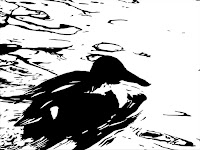copyright Katherine Tyrrell
I've been doing a lot of thinking lately - especially as I drew my very handsome male shoveler duck in pen and ink - about needing to practice line drawing in a two value Notan sense if I'm going to have a go at lino-cutting.
I've decided to practice by reviewing how to convert photos into just two tones using the PS Elements Cut Out Tool so that I can see if I can develop a better "eye" for doing two tone work
First a quick reminder about what Notan is - plus some links to previous posts on this blog for readers not familiar with the concept.
Notan is a Japanese concept involving the placement of lights and darks next to the other to read as flat shapes on the two-dimensional surface. This use of lights and darks differs dramatically from the means by which artists had traditionally manipulated these elements to create seemingly three-dimensional forms on the picture plane.Some readers will recall I've written about this previously
Line melts into tone through the cluster of many lines. Direct study of tone-intervals begins with composition in two values - the simplest form of Notan.
Arthur Wesley Dow
- Georgia O'Keeffe Month: Learning about Notan #1 - which explains what Notan is
- Georgia O'Keeffe Month: Learning about Notan #2 - particularly instructive about processes for two value Notan and composing using Notan
- A little notan in the morning - an example in coloured pencils using (nearly!) two colours
- Georgia O'Keeffe Month: Learning about Notan #3 - which highlights the problems experienced when introducing colour into the design
So this post remedies that omission!
How to reduce a photo to a two value image
I'm also going to drop in one or two of the Arthur Wesley Dow's recommendations for how to make Notan work
focus first on ensuring that the line design works before beginning to darken certain shapes within the overall design with black
- Locate the cut out tool in PS Elements. This is one of the artistic filters. So the menu selection in PS Elements goes Filter/Artistic/Cutout.
- Note how many ways you can vary the cutout. There are three controls Number of Levels, Edge Simplicity and Edge Fidelity. I'll describe each in terms of what happens at the extremes.
- Numbers of Levels: There are eight levels. 1= one value/colour. 8 = 8 values and values/shades of grey between black and white
- Edge Simplicity: There are ten levels 1= picks up all the tiny marks; 10= extreme simplicity/very abstract/subject is unrecognisable
- Edge Fidelity: There are three options. 1 = simplest; 3 = most accurate. 2 looks like it might be a good level for lino-cuts
- Select a photo to adapt and create a two value image (for a linocut). (Squint!) Check whether it has interesting lines and whether the big value shapes are distinctive. Basically any mental screening you do is trying to identify pattern and balance and to imagine what it would look like with no colour.
- Save the photo with a new file name
- Select Image/Mode/Greyscale and convert to greyscale
- Start to play around with the three controls. While keeping the other two at mid points, check what happens when you take any of the to the two extremes. Make a note of what you find out and note what each does to value, shape and line.
- Repeat for each of the three controls
- Now select two levels to produce a two value image. Do a basic check on whether it looks like it still has the potential to be interesting.
- Then vary the simplicity of the edge. Find a level which looks like it could be feasible to draw and cut on lino!
- Then vary the difference of the fidelity and see what happens.
- Try varying fidelity first. Hold simplicity at 5 and then vary fidelity.
The realistic standard always tends to the decay of artI've got an example from a photo of my Shoveler. I liked the patterns in the water and thought the duck shape was also quite distinctive - but I wasn't sure how it would work when reduced down to two values and some fiddling with edges!
Arthur Wesley Dow, Composition
 Here are the results.
Here are the results.- Numbers of Levels: 2
- Edge Simplicity: 5
- Edge Fidelity: 5
In version 2 I increased the simplicity (i.e. made it more faithful to reality) and then reduced the fidelity! It produces more slight lines which are areas of no line on the other two.
- Numbers of Levels: 2
- Edge Simplicity: 6
- Edge Fidelity: 1
In version 3 I reduced the simplicity and increased the fidelity
- Numbers of Levels: 2
- Edge Simplicity: 4
- Edge Fidelity: 3
Now can I do this by eye alone - or do linocutters also look to PS for help?
If you want to take a look at somebody who regularly does linocuts - take a look at Sherrie York's linocut gallery on her website and her blog Brush and Baren. I also recommend taking a look at her Great Crested Grebe Linocut and reading an excellent interview with her on Printsy - which I think one or two other lino cutting students have already spotted - hi Robyn!! ;)
Lino Cutting Note: My information site to store all my bookmarks for lino cutting is already in draft. Inevitable really - as soon as I started to look at equipment and materials! Any recommendations for links to useful sites will be much appreciated. I'll let you know when I start to cut!
and finally......
Please leave a comment below (and a link to your example) if you have a go at using this technique.
Links:


















